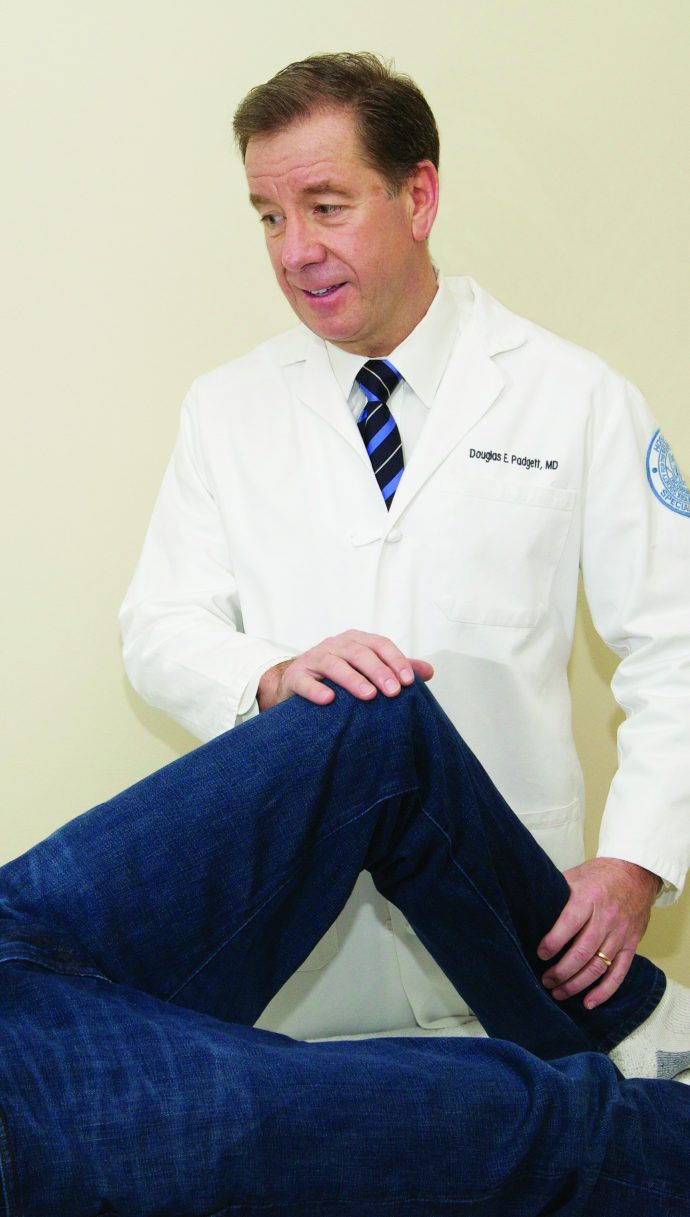In today’s world, most of us know someone who has had joint replacement surgery.
Be it hip or knee, the procedure has proliferated over the past four decades, offering blessed pain relief and freedom of motion to millions.
Douglas E. Padgett, a Harrison resident who is chief of Adult Reconstructive and Joint Replacement Surgery at Manhattan’s Hospital for Special Surgery, has been at the forefront of many of the major advances that have taken place in the field.
“In the world of joint replacement surgery, the Hospital for Special Surgery is ground zero,” says Padgett, who’s been chief for six years and with the hospital for 19. “It’s what we do and we have the greatest collection of medical professionals in the world under one roof. We are the go-to place in this field.”
Evolution
Total joint replacement surgery involves the replacement of arthritic or diseased bone with implants that restore proper pain-free function to the joint. All joint replacements have potential problems but today successful outcomes are in the vast majority. Patients who have good reason to expect excellent results.
“Modern hip and knee surgery took hold in the 1970s and moved ahead throughout the 1980s,” Padgett says. “Prior to that it was very rudimentary and was used primarily for extremely painful arthritis.”
As changes took place, the Hospital for Special Surgery led the charge.
“We pushed forward as the years went by, always being in the forefront of advances that were made,” he says. “I was fortunate to be under the tutelage of Dr. John Insall, Dr. Chit Ranawat and Dr. Philip Wilson. They were pioneers and my personal mentors, forming the basis for modern techniques in joint replacement.
“Hip replacement surgery has made amazing strides forward,” Padgett says. “In the old days, prosthetic hips were usually cemented into place. Today, the cement is used less frequently and we currently use techniques that permit the hipbone to biologically bond itself to the prosthesis. We no longer have to worry about glue breakdown. By the end of the 1990s, implant loosening was an infrequent occurrence.”
But surgeons were not out of the woods just yet.
“The new problem became prosthetic surfaces wearing out,” he says. “We experimented with combinations of medical grade plastics, polished metal and ceramics. Each had its good and bad points. For example, ceramics are brittle and can break. Ceramic implants can also squeak and cause friction. Some metal-on-metal components would produce metal debris inside the joint, and metal on metal began falling out of favor.”
Padgett says improvements in medical-grade plastics saved the day.
“These were much better and highly resistant to wear and tear. After 12 years of follow-up, we have decided that a ball of highly polished metal or ceramic and a socket of medical-grade plastic give the best result.”
The use of robotics in joint surgery is another advantage for doctors and patients.
“The key to long-term performance is having a good ball and socket,” Padgett says. “But they must be put in the optimum position. We now have new technologies, including robotics, to assist in the implantation of devices. I now routinely use robotic techniques for implants. This is a tremendous advance.”
Like hips, knees have seen a vast improvement in excellent surgical outcomes.
“Even into the l980s, knee replacement prostheses were very simplistic,” Padgett says. “The first generation came in only three sizes – small, medium and large. There were difficulties with getting a good fit and good function.”
Today there have been major advances in the design of knee replacement prostheses.
“We now have a much better understanding of how the knee functions and the old-fashioned designs are gone,” Padgett says. “The improvements in knee implant design have been dramatic and resulted in a high success rate.”
After the surgery
Padgett says that along with improvements in implant design and surgical techniques, the approach to recovery from joint replacement surgery has also taken big strides forward.
“Long-term in-patient rehabilitation for joint replacement is on the wane,” he says, “and we do much more with preoperative patient education. We have also taken a long look at pain management and changed our approach. We use a combination of different medications that reduce nerve, bone and inflammatory pain. And postoperative hospital stays have also shortened dramatically.
“Two days in the hospital is now standard for hips and two to three for knees,” Padgett says. “We urge our patients to resume their regular lifestyles – within reason, of course – as soon as possible. I have patients who are playing tennis and jogging a few months after surgery, even though we encourage people to avoid loading up on these types of high-impact activities. I tell them we don’t know the long-term effects on their new joints and caution them to use common sense.”
Padgett is gratified at the advances in his field.
“In the early 1980s, there were only a few hospitals in the world performing joint replacement surgery,” he says. “In 2014, all major hospitals do it. I have watched the story unfold and it is very rewarding. Seeing my patients pain-free and back to their usual routines is great. Today we have 98 percent good outcomes. It is that two percent that keeps me awake at night. We still need to crack the code with surgical methods that will make this operation the best it can possibly be for all patients.”


